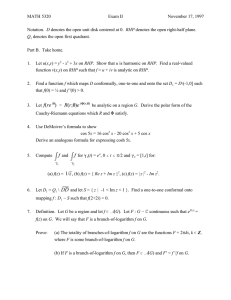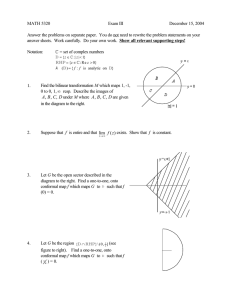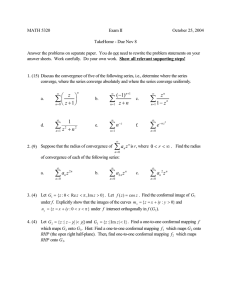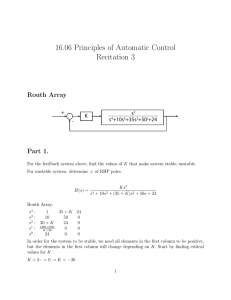Section II. Executive Overview of RHP
advertisement
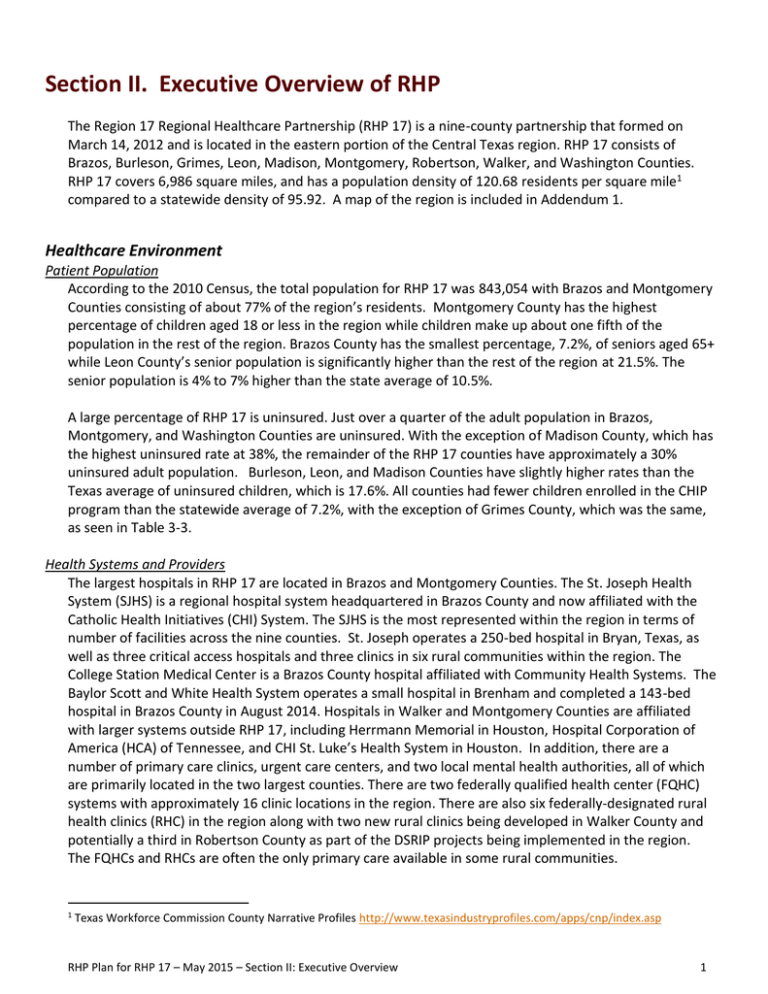
Section II. Executive Overview of RHP The Region 17 Regional Healthcare Partnership (RHP 17) is a nine-county partnership that formed on March 14, 2012 and is located in the eastern portion of the Central Texas region. RHP 17 consists of Brazos, Burleson, Grimes, Leon, Madison, Montgomery, Robertson, Walker, and Washington Counties. RHP 17 covers 6,986 square miles, and has a population density of 120.68 residents per square mile1 compared to a statewide density of 95.92. A map of the region is included in Addendum 1. Healthcare Environment Patient Population According to the 2010 Census, the total population for RHP 17 was 843,054 with Brazos and Montgomery Counties consisting of about 77% of the region’s residents. Montgomery County has the highest percentage of children aged 18 or less in the region while children make up about one fifth of the population in the rest of the region. Brazos County has the smallest percentage, 7.2%, of seniors aged 65+ while Leon County’s senior population is significantly higher than the rest of the region at 21.5%. The senior population is 4% to 7% higher than the state average of 10.5%. A large percentage of RHP 17 is uninsured. Just over a quarter of the adult population in Brazos, Montgomery, and Washington Counties are uninsured. With the exception of Madison County, which has the highest uninsured rate at 38%, the remainder of the RHP 17 counties have approximately a 30% uninsured adult population. Burleson, Leon, and Madison Counties have slightly higher rates than the Texas average of uninsured children, which is 17.6%. All counties had fewer children enrolled in the CHIP program than the statewide average of 7.2%, with the exception of Grimes County, which was the same, as seen in Table 3-3. Health Systems and Providers The largest hospitals in RHP 17 are located in Brazos and Montgomery Counties. The St. Joseph Health System (SJHS) is a regional hospital system headquartered in Brazos County and now affiliated with the Catholic Health Initiatives (CHI) System. The SJHS is the most represented within the region in terms of number of facilities across the nine counties. St. Joseph operates a 250-bed hospital in Bryan, Texas, as well as three critical access hospitals and three clinics in six rural communities within the region. The College Station Medical Center is a Brazos County hospital affiliated with Community Health Systems. The Baylor Scott and White Health System operates a small hospital in Brenham and completed a 143-bed hospital in Brazos County in August 2014. Hospitals in Walker and Montgomery Counties are affiliated with larger systems outside RHP 17, including Herrmann Memorial in Houston, Hospital Corporation of America (HCA) of Tennessee, and CHI St. Luke’s Health System in Houston. In addition, there are a number of primary care clinics, urgent care centers, and two local mental health authorities, all of which are primarily located in the two largest counties. There are two federally qualified health center (FQHC) systems with approximately 16 clinic locations in the region. There are also six federally-designated rural health clinics (RHC) in the region along with two new rural clinics being developed in Walker County and potentially a third in Robertson County as part of the DSRIP projects being implemented in the region. The FQHCs and RHCs are often the only primary care available in some rural communities. 1 Texas Workforce Commission County Narrative Profiles http://www.texasindustryprofiles.com/apps/cnp/index.asp RHP Plan for RHP 17 – May 2015 – Section II: Executive Overview 1 RHP 17 has a full continuum of care which is primarily available in Brazos and Montgomery Counties. It includes health promotion, primary care, specialty care, chronic disease management, labor and delivery, general and specialty surgery, intensive care, behavioral health care services, rehabilitation, emergency care, and many others. In most cases, limited primary care can be obtained locally but more preventative screenings and specialty care must be accessed in Brazos or Montgomery Counties or even outside the region, most commonly in the Houston area. This can create transportation issues for many residents in RHP 17, may result in long waits to access certain types of care, and may oftentimes prevent some residents from ever receiving the health care they need. Key Health Challenges The key health challenges in RHP 17 are like many areas in Texas. Addressing these health care needs will require broad system transformation and collaboration among health care providers and organizations. The broad key health challenges in RHP 17 include: Poor access to primary care; Poor access to specialty care; Poor access to behavioral/mental health services; and Lack of coordinated care, especially for those with multiple needs. Access to quality primary care is a challenge throughout most of the region because health care is concentrated in Brazos and Montgomery Counties. Although centrally located within the region, Brazos County is not located on or near an interstate highway. State highways leading into Brazos County from the east and north are predominantly two lane highways. Montgomery County is located in the southeastern part of the region. Professionals in the rural areas are frequently stretched very thin, making access difficult. More specialized care in these areas can be all but impossible to obtain. The need for expanded primary care capacity, especially for the uninsured and underinsured population, is an issue in all counties, not just rural counties. Population growth in these counties is outpacing the growth in the number of health care professionals. Access to behavioral health and mental health services is also a large concern. There are two local mental health authorities in RHP 17, but they are challenged to keep up with demand and limited by their eligibility criteria, which only allows for them to serve those at risk of severe and persistent mental health disorders. Transportation issues can again make seeking services inconvenient. RHP 17 lacks coordinated care. This causes residents, especially those who have multiple needs or have limited access to services, to use inappropriate and more expensive services, such as the emergency room or emergency medical services. In particular, in regional planning meetings, RHP 17 providers reported treatment of individuals with chronic disease, individuals with co-occurring mental health and chronic disease, and individuals with intellectual disabilities and mental health issues to be a challenge with the resources available. Each of these key challenges, if resolved, would provide better quality of life and reduce the burden on our criminal justice system, hospitals and emergency departments. RHP Plan for RHP 17 – May 2015 – Section II: Executive Overview 2 RHP Goals and Vision, and Plans for Achieving the Goals The overarching goal of RHP 17 is to transform the local and regional health care delivery systems to improve access to care, efficiency, and effectiveness. Specifically, RHP 17 will address the key challenges listed above and will aim to resolve these by reaching four primary goals. The plans for achieving those goals are outlined below under each goal: 1) Expanding the availability of and access to timely, high quality primary, specialty, and behavioral health care for residents, including those with multiple needs; Providers in RHP 17 will achieve this goal by expanding the availability and capacity of primary care in the region, as well as expanding the services available through primary care providers. In addition to expanded clinic hours, there are plans to explore implementation of rural fellowships and allow primary care residents to be placed in rural areas, expand capacity at safety net clinics, implement mobile primary care screenings, target disparity groups with evidence based health promotion, disease prevention and chronic care management, and increasing behavioral health care via telehealth and mobile clinics in rural communities. Some of these new services will focus on managing chronic conditions, while others will focus on decreasing potentially preventable admissions/readmissions, inappropriate ED use, and/or aim to improve patient satisfaction, an indicator of quality of care. 2) Increasing the proportion of residents with a regular source of care; The expansion of primary care capacity in the region will provide opportunities for residents to establish a regular source of care. In addition to availability, new patient navigation programs will refer patients who are currently without a regular source of care to available primary care providers. 3) Increasing coordination of preventative, primary, specialty, and behavioral health care for residents, including those with multiple needs; and The coordination of care in the region will better address the community needs by integrating primary and behavioral health services, integrating behavioral health services with services for the intellectually and developmentally disabled, and creating patient navigation programs to ensure residents who access more inappropriate settings of care can develop a regular source of care. 4) Reducing costs by minimizing inappropriate utilization of services. Given the largely rural nature of RHP 17, inappropriate utilization of services is a critical issue as many needed services simply are not available locally. All of the activities described under Goals 1, 2 and 3 above, in theory, will reduce inappropriate utilization of the emergency department (ED), the criminal justice system and emergency medical services. The expansion of primary care availability and accessibility, care coordination through patient navigation, targeted behavioral health services, and evidence-based health promotion/disease prevention targeting high risk and disparate populations all serve to get people into the right care at the right time. Specific outcomes of interest include, but are not limited to, appropriate utilization of the ED and reducing the ambulatory care sensitive admission rate. RHP Plan for RHP 17 – May 2015 – Section II: Executive Overview 3 TABLE 2-1. RHP CATEGORY 1 & 2 PROJECTS Project Title (include Project unique RHP project ID Area number) Category 1: Infrastructure Development Brief Project Description Related Category 3 Outcome Measures 130982504.3.1 IT-6.2.b Visit-Specific Satisfaction Instrument (VSQ9) IT-15.17 Latent Tuberculosis Infection (LTBI) treatment rate 020841501.3.2 IT-3.3 Risk Adjusted Congestive Heart Failure (CHF) 30-day Readmission Rate 189791001.3.1 IT-3.8 Acute Myocardial Infarction (AMI) 30 -day Readmission Rate 189791001.3.2 IT-1.16 Hemodialysis Adequacy Clinical Performance Measure III Estimated Incentive Amount (DSRIP) 1.10.2 Title: Implementation of an EHR System at Brazos County Health District Enhance Performance Improvement and Reporting Capacity Through Technology 1.9.2 Title: Expand Access to Specialized Trauma Services Improve Access to Specialty Care 1.9.2 Title: HMH Cardiac Catheterization Laboratory Improve Access to Specialty Care 1.9.2 Title: HMH Inpatient Dialysis Laboratory Improve Access to Specialty Care 189791001.1.3 Huntsville Memorial Hospital 1.9.1 Title: Nursing Fellowship Program to Provide Training in Specialty Areas Expand High-Impact Specialty Care Capacity in Most Impacted Medical Specialties 189791001.3.3 IT-4.5 Patient Fall Rate $1,408,859 * PASS 2 PROJECT* 189791001.1.4 Huntsville Memorial Hospital 1.1.3 Title: Mobile office to provide screenings, vaccination, physicals and health education Expand Mobile Clinics 189791001.3.4 IT-2.17 Uncontrolled Diabetes Admissions Rate $4,120,022 Title: Huntsville Memorial Hospital’s Primary Care and Non-Emergent Services in Rural Areas Establish More Primary Care Clinics 189791001.3.100 IT-1.13 Diabetes care: Foot exam 189791001.3.101 IT-1.21 Adult Body Mass Index (BMI) Assessment 189791001.3.102 IT-1.23 Tobacco Use: Screening & Cessation $3,533,523 130982504.1.1 Brazos County Health District 020841501.1.2 Conroe Regional Medical Center 189791001.1.1 Huntsville Memorial Hospital 189791001.1.2 Huntsville Memorial Hospital * 3 YEAR PROJECT* 189791001.1.100 Huntsville Memorial Hospital 1.1.1 RHP Plan for RHP 17 – May 2015 – Section II: Executive Overview $432,000 $785,294 $2,641,613 $1,408,859 4 TABLE 2-1. RHP CATEGORY 1 & 2 PROJECTS Project Title (include unique RHP project ID number) Estimated Incentive Amount (DSRIP) Project Area Brief Project Description 1.1.2 Title: Expanding Primary Care Access in Montgomery County Expand Existing Primary Care Capacity 160630301.3.1 IT-2.21 Ambulatory Care Sensitive Conditions Admissions Rate $7,634,803 * 3 YEAR PROJECT* 160630301.1.100 St. Luke's - The Woodlands Hospital 1.3.1 Title: Implementing a Chronic Disease Management Registry Implement/Enhance and Use Chronic disease Management Registry Functionalities 160630301.3.100 IT-3.17 Risk Adjusted Chronic Obstructive Pulmonary Disease (COPD) 30-day Readmission Rate $1,591,061 135226205.1.1 Scott & White Hospital Brenham 1.1.2 Title: Increasing Primary Care Provider Time at Brenham Free Clinic Expand Existing Primary Care Capacity 1.1.2 Title: HFA Capacity: Expanding Access to Primary Care/Preventive Services, Improving Transition of Care, and Improving Quality of Care for the Indigent Population of Brazos and Surrounding Counties Expand Existing Primary Care Capacity 160630301.1.1 St. Luke's - The Woodlands Hospital 198523601.1.1 Texas A&M Physicians RHP Plan for RHP 17 – May 2015 – Section II: Executive Overview Related Category 3 Outcome Measures 135226205.3.2 IT-9.2.a Emergency Department (ED) visits per 100,000 198523601.3.1 IT-1.7 Controlling High Blood Pressure 5 $364,865 $669,349 TABLE 2-1. RHP CATEGORY 1 & 2 PROJECTS Project Title (include unique RHP project ID number) Related Category 3 Outcome Measures Estimated Incentive Amount (DSRIP) 198523601.3.5 IT-11.26.e.i Patient Health Questionnaire 9 (PHQ-9) $2,948,607 081844501.3.1 IT-11.26.e.i Patient Health Questionnaire 9 (PHQ-9) $5,035,447 1.13.1 Title: IDD Assertive Community Treatment Program Develop and implement crisis stabilization services to address the identified gaps in the current community crisis system 081844501.3.2 IT-11.26.b Aberrant Behavior Checklist (ABC) $1,151,178 1.9.2 Title: Expanded Psychiatry Delivery Program Improve Access to Specialty Care 081844501.3.3 IT-11.26.e.iii Patient Health Questionnaire: Somatic, Anxiety, and Depressive Symptoms (PHQ-SADS) $1,962,935 Project Area 198523601.1.4 Texas A&M Physicians 1.11.2 081844501.1.1 Tri-County Services MHMR 1.13.1 081844501.1.2 Tri-County Services MHMR 081844501.1.3 Tri-County Services MHMR Brief Project Description Title: Expanding Telemental Health Services Throughout the Brazos Valley Implement technology-assisted behavioral health services from psychologists, psychiatrists, substance abuse counselors, peers and other qualified providers Title: Intensive Evaluation and Diversion Program Develop and implement crisis stabilization services to address the identified gaps in the current community crisis system RHP Plan for RHP 17 – May 2015 – Section II: Executive Overview 6 TABLE 2-1. RHP CATEGORY 1 & 2 PROJECTS Project Title (include unique RHP project ID number) Project Area Brief Project Description Category 2: Program Innovation and Redesign Title: Free Rapid HIV Testing to Targeted Clients at High-Risk for Contracting HIV 130982504.2.1 Implement innovative evidence-based strategies to Brazos County Health 2.7.1 increase appropriate use of technology and testing for District targeted populations (e.g., mammography screens, colonoscopies, prenatal alcohol use, etc.) Title: Advanced Community Paramedicine (ACP) Navigation Program 020860501.2.1 Provide navigation services to targeted patients who College Station Medical 2.9.1 are at high risk of disconnect from institutionalized Center health care (for example, patients with multiple chronic conditions, cognitive impairments and disabilities, Limited English Proficient patients) * PASS 2 PROJECT* Title: Program to enable patient to better manage their health; Chronic Care Management Models 189791001.2.1 2.2.2 Apply Evidence-Based Care Management Model to Huntsville Memorial Patients Identified as having High-Risk Health Care Hospital Needs 136366507.2.1 MHMR Authority of Brazos Valley 2.13.1 Title: Crisis Triage Unit Design, Implement and Evaluate Research-Supported and Evidence Based interventions tailored towards individuals in a target population RHP Plan for RHP 17 – May 2015 – Section II: Executive Overview Related Category 3 Outcome Measures 130982504.3.200 IT-15.10 Syphilis positive screening rates 130982504.3.201 IT-15.13 Gonorrhea Positive Screening Rates 130982504.3.2 IT-15.6 Chlamydia screening in women Estimated Incentive Amount (DSRIP) $43,200 020860501.2.1 IT-9.4.b Reduce Emergency Department visits for Diabetes $1,371,890 189791001.3.5 IT-3.4 Diabetes 30 day Readmission Rate $5,025,575 136366507.3.1 IT-1.18 Follow-Up After Hospitalization for Mental Illness 136366507.3.500 IT-11.26.c Adult Needs and Strength Assessment (ANSA) with CHMC.5 - Adherence To Antipsychotic Meds $1,153,000 7 TABLE 2-1. RHP CATEGORY 1 & 2 PROJECTS Project Title (include Project unique RHP project ID Area number) 136366507.2.2 MHMR Authority of Brazos Valley 127267603.2.1 St. Joseph Regional Health Center Related Category 3 Outcome Measures Estimated Incentive Amount (DSRIP) 2.13.1 Title: Rural ACT/Jail Diversion/Crisis Specialist Design, Implement and Evaluate Research-Supported and Evidence Based interventions tailored towards individuals in a target population 136366507.3.2 IT-9.1 Decrease in Mental Health Admissions and Readmissions to Criminal Justice Settings $1,085,000 2.9.1 Title: Community Paramedicine (CP): Provide Navigation Services to Targeted Patients Who are at High Risk of Disconnect from Institutionalized Health Care. Provide navigation services to targeted patients who are at high risk of disconnect from institutionalized health care (for example, patients with multiple chronic conditions, cognitive impairments and disabilities, Limited English Proficient patients) 311035501.3.100 IT-9.2 Reduce Emergency Department (ED) visits for Ambulatory Care Sensitive Conditions (ACSC) per 100,000 $4,167,500 2.9.1 Title: Prenatal Care Navigation Program Provide navigation services to targeted patients who are at high risk of disconnect from institutionalized health care (for example, patients with multiple chronic conditions, cognitive impairments and disabilities, Limited English Proficient patients) 127267603.3.1 IT-8.19 Post-Partum Follow-Up and Care Coordination * 3 Year PROJECT* 311035501.2.100 Montgomery County Health District Brief Project Description RHP Plan for RHP 17 – May 2015 – Section II: Executive Overview 8 $662,589 TABLE 2-1. RHP CATEGORY 1 & 2 PROJECTS Project Title (include Project unique RHP project ID Brief Project Description Area number) Title: Improving Primary Care and Supportive Services to Reduce Avoidable ED and Hospital Visits 135226205.2.1 at Scott & White Hospital in Brenham Scott & White Hospital 2.8.1 Design, develop, and implement a program of Brenham continuous, rapid process improvement that will address issues of safety, quality, and efficiency. 198523601.2.1 Texas A&M Physicians 2.1.1 198523601.2.2 Texas A&M Physicians 2.6.2 198523601.2.3 Texas A&M Physicians 2.9.1 198523601.2.4 Texas A&M Physicians 2.10.1 * PASS 2 PROJECT* 081844501.2.1 Tri-County Services MHMR 2.15.1 Title: Development of a Redesign Process for Transforming Primary Care Clinics and Providers to the PCMH/Guided Care Model Develop, Implement and Evaluate Action Plans to Enhance/Eliminate Gaps in the Development of Various Aspects of PCMH Standards Title: EBP Resource Exchange: Training, Implementation and Evaluation of Evidence-Based Self-Management and Wellness Programs Establish Self-Management Programs and Wellness using Evidence-based Designs Title: Brazos Post Discharge Patient Care Coordination Provide navigation services to targeted patients who are at high risk of disconnect from institutionalized health care (for example, patients with multiple chronic conditions, cognitive impairments and disabilities, Limited English Proficient patients) Title: Home-Based Palliative Care Implement a Palliative Care Program to address patients with end-of-life decisions and care needs Title: Integrated Primary and Behavioral Health Care Services with included Mobile Clinic Component Design, implement, and evaluate projects that provide integrated primary and behavioral health care services. RHP Plan for RHP 17 – May 2015 – Section II: Executive Overview Related Category 3 Outcome Measures 135226205.3.4 IT-9.2.a Emergency Department (ED) visits per 100,000 Estimated Incentive Amount (DSRIP) $364,865 198523601.3.6 IT-1.10 Diabetes care: HbA1c poor control (>9.0%) $1,338,669 198523601.3.7 IT-10.1.h CDC Health-Related Quality of Life (HRQoL) Measures $1,784,931 198523601.3.8 IT-6.2.c Health Center Patient Satisfaction Survey $4,462,338 198523601.3.9 IT-10.1.d McGill Quality of Life (MQOL) Index 081844501.3.4 IT-1.7 Controlling high blood pressure 9 $446,232 $3,961,178
